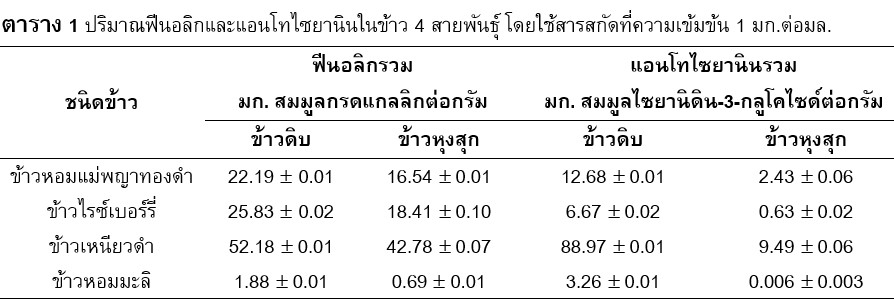Comparison of phenolic and anthocyanin content among four differences of raw and cooked rice
Keywords:
Purple cooked rice, phenolic content, anthocyanin contentAbstract
The study is aimed to determine phenolic and anthocyanin content among 4 differences of raw and cooked rice. The phenolic content of raw|cooked rice in mg gallic acid equivalent (SD), among black sticky rice, riceberry, Khaohommaephyathongdam, and jasmine rice, were 52.18 (0.01)|42.78 (0.07), 25.83 (0.02)|18.41 (0.10), 22.19 (0.01)|16.54 (0.01) and 1.88 (0.01)|0.69 (0.01), respectively. While the anthocyanin content of raw|cooked rice in mg cyanidin-3-glucoside equivalent (SD), among black sticky rice, Khaohommaephyathongdam, riceberry, and jasmine rice, were 88.97 (0.01)|9.49 (0.06), 12.68 (0.01)|2.43 (0.06), 6.67 (0.02)|0.63 (0.02) and 3.26 (0.01)|0.006 (0.003), respectively. In fact, soaking before cooking and wet cooking can also reduce the phenolic and anthocyanin contents.
References
Seigler DS. Plant Secondary Metabolism. New York: Springer Science: Business Media; 1995.
Jones ME, Kossel A. A biographical sketch. Yale J Biol Med. 1953;26(1):80-97.
Bourgaud F, Gravot A, Milesi S, Gontier E. Production of plant secondary metabolites: A historical perspective. Plant Sci. 2001;161: 839-51.
Golawska S, Sprawka I, Lukasik I, Golawski A. Are naringenin and quercetin useful chemicals in pest-management strategies? J Pest Sci. 2014;87(1):173-80.
Martín Bueno J, Ramos-Escudero F, Sáez-Plaza P, Muñoz AM, Navas MJ, Asuero AG. Analysis and antioxidant capacity of anthocyanin pigments. Part I: general considerations concerning polyphenols and flavonoids. Crit Rev Anal Chem. 2012;42: 102–25.
Martín Bueno J, Sáez-Plaza P, Ramos-Escudero F, Jímenez AM, Fett R, Asuero AG. Analysis and antioxidant capacity of anthocyanin pigments. Part II: chemical structure, color and intake of anthocyanins. Crit Rev Anal Chem. 2012;42:126–51.
Kusirisin W, Jaikang C, Chaiyasut C, Narongchai P. Effect of polyphenolic compounds from Solanum torvum on plasma lipid peroxidation, superoxide anion and cytochrome P450 2E1 in human liver microsomes. Med Chem. 2009;5(6):583-8.
Yang X, Yan F, Huang S, Fu C. Antioxidant activities of fractions from longan pericarps. Food Sci Technol. 2014;34(2):341-5.
Kim MK, Kim HA, Koh K, Kim HS, Lee YS, Kim YH. Identification and quantification of anthocyanin pigments in colored rice. Nutr Res Pract. 2008;2(1):46-9.
Goffman FD, Bergman CJ. (2004), Rice kernel phenolic content and its relationship with antiradical efficiency. J Sci Food Agric. 2004;84:1235-40.
Tian S, Nakamura K, Kayahara H. Analysis of phenolic compounds in white rice, brown rice, and germinated brown rice. J Agric Food Chem. 2004;52:4808-13.
Zhou Z, Robards K, Helliwell S, Blanchard C. The distribution of phenolic acids in rice. Food Chem, 2004;87:401-6.
Zhang MW, Guo BJ, Zhang RF, Chi JW. We ZC, Xu ZH, Zhang Y, Tang XJ. Separation, purification and identification of antioxidant compositions in black rice. Agric Sci China. 2006;5:431-40.
Oki T, Masuda M, Kobayashi M, Nishiba Y, Furuta S, Suda I, Sato T. Polymeric procyanidins as radical - scavenging components in red-hulled rice. J Agric Food Chem. 2002;50:7524-9.
Hu C, Zawistowski J, Ling W, Kitts DD. Black rice (Oryza sativa L. indica) pigmented fraction suppresses both reactive oxygen species and nitric oxide in chemical and biological model systems. J Agric Food Chem. 2003;51:5271-7.
Chen P, Kuo W, Chiang C, Chiou H, Hsieh Y, Chu S. Black rice anthocyanins inhibit cancer cells invasion via repressions of MMPs and u-PA expression. Chem-Biol Interact. 2006; 163:218-29.
Yawadio R, Tanimori S, Morita N. Identification of phenolic compounds isolated from pigmented rices and their aldose reductase inhibitory activities. Food Chem. 2007;101:1616-25.
Yamuangmorn S, Dell B, Prom-u-thai C. Effects of cooking on anthocyanin concentration and bioactive antioxidant capacity in glutinous and non-glutinous purple rice. Rice Sci. 2018;25(5):270–8.
Bhawamai S, Lin SH, Hou YY, Chen YH. (2016). Thermal cooking changes the profile of phenolic compounds but does not attenuate the anti-inflammatory activities of black rice. Food Nutr Res. 2016;60(1): 32941(1-9).

Downloads
Published
How to Cite
Issue
Section
License
Copyright (c) 2020 Naresuan Phayao Journal

This work is licensed under a Creative Commons Attribution-NonCommercial-NoDerivatives 4.0 International License.
ผู้นิพนธ์ต้องรับผิดชอบข้อความในบทนิพนธ์ของตน มหาวิทยาลัยพะเยาไม่จำเป็นต้องเห็นด้วยกับบทความที่ตีพิมพ์เสมอไป ผู้สนใจสามารถคัดลอก และนำไปใช้ได้ แต่จะต้องขออนุมัติเจ้าของ และได้รับการอนุมัติเป็นลายลักษณ์อักษรก่อน พร้อมกับมีการอ้างอิงและกล่าวคำขอบคุณให้ถูกต้องด้วย
The authors are themselves responsible for their contents. Signed articles may not always reflect the opinion of University of Phayao. The articles can be reproduced and reprinted, provided that permission is given by the authors and acknowledgement must be given.







